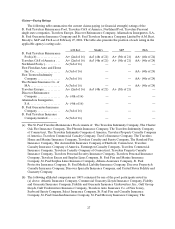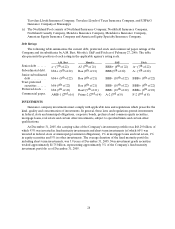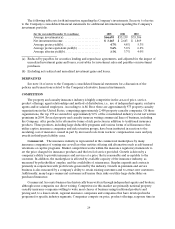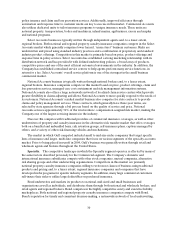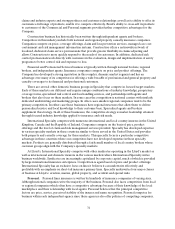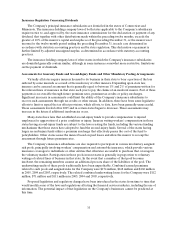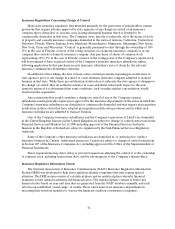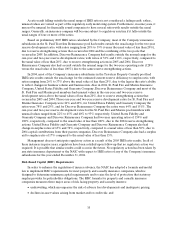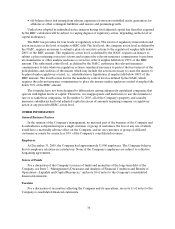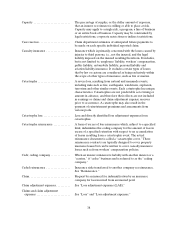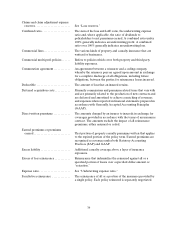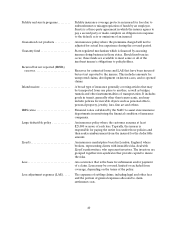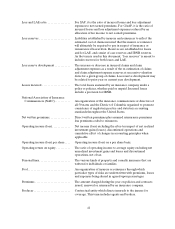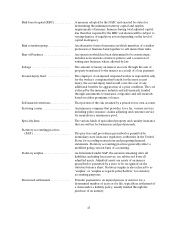Travelers 2005 Annual Report Download - page 45
Download and view the complete annual report
Please find page 45 of the 2005 Travelers annual report below. You can navigate through the pages in the report by either clicking on the pages listed below, or by using the keyword search tool below to find specific information within the annual report.33
Insurance Regulation Concerning Dividends
The Company’s principal insurance subsidiaries are domiciled in the states of Connecticut and
Minnesota. The insurance holding company laws of both states applicable to the Company’s subsidiaries
require notice to, and approval by, the state insurance commissioner for the declaration or payment of any
dividend, that together with other distributions made within the preceding twelve months, exceeds the
greater of 10% of the insurer’s capital and surplus as of the preceding December 31, or the insurer’s net
income for the twelve-month period ending the preceding December 31, in each case determined in
accordance with statutory accounting practices and by state regulation. This declaration or payment is
further limited by adjusted unassigned surplus, as determined in accordance with statutory accounting
practices.
The insurance holding company laws of other states in which the Company’s insurance subsidiaries
are domiciled generally contain similar, although in some instances somewhat more restrictive, limitations
on the payment of dividends.
Assessments for GuarantyFunds and Second-Injury Funds and Other Mandatory Pooling Arrangements
Virtually all states require insurers licensed to do business in their state to bear a portion of the loss
suffered by some insureds as a result of the insolvency of other insurers. Depending upon state law,
insurers can be assessed an amount that is generally equal to between 1% and 2%of premiums written for
the relevant lines of insurance in that state each year to pay the claims of an insolvent insurer. Part of these
payments is recoverable through future premium rates, premium tax credits or policy surcharges.
Significant increases in assessments could limit the ability of the Company’s insurance subsidiaries to
recover such assessments through tax credits or other means. In addition, there have been some legislative
efforts to limit or repeal the tax offset provisions, which efforts, to date, havebeen generally unsuccessful.
These assessments leveled off in 2005 and in certain states began to decrease. These assessments may
increase in the future if additional insolvencies occur.
Many states have laws that established second-injury funds to provide compensation toinjured
employees for aggravation of a prior condition or injury. Insurers writing workers’ compensation in those
states having second-injury funds are subject to the laws creating the funds, including the various funding
mechanisms that those states have adopted to fund the second-injury funds. Several of thestates having
larger second-injury funds utilize a premium surcharge that effectively passes the cost of the fundto
policyholders. Other states assess the insurer based on paid losses and allow the insurer to recoup the
assessment through future premium rates.
The Company’s insurance subsidiaries are also required to participate in various involuntary assigned
risk pools, principally involving workers’ compensation and automobile insurance, which provide various
insurance coverages to individuals or other entities that otherwise are unable to purchase that coverage in
the voluntary market. Participation in these pools in most states is generally in proportion to voluntary
writings of related lines of business in that state. In the event that a member of that pool becomes
insolvent, the remaining members assume an additional pro rata share of the liabilities of the pool. The
underwriting results of these pools traditionally have beenunprofitable. Combined earned premiums
related to such pools and assigned risks for the Company were $174 million, $168 million and $160 million
in 2005, 2004 and 2003, respectively. The related combined underwriting losses for the Company were $112
million, $71 million and $111 million in 2005, 2004 and 2003, respectively.
Proposed legislation and regulatory changes have been introduced in the states from time to time that
would modify some of the laws and regulations affecting the financial services industry, including the use of
information. The potential impact of that legislation on the Company’s businesses cannot be predicted at
this time.






